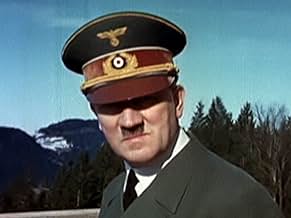The Nazification of Germany from 1933 to 1945 told through a compilation of Nazi footage, newsreels, propaganda films and Eva Braun's home movies.The Nazification of Germany from 1933 to 1945 told through a compilation of Nazi footage, newsreels, propaganda films and Eva Braun's home movies.The Nazification of Germany from 1933 to 1945 told through a compilation of Nazi footage, newsreels, propaganda films and Eva Braun's home movies.
Galeazzo Ciano
- Self
- (archive footage)
Albert Einstein
- Self
- (archive footage)
Joseph Goebbels
- Self
- (archive footage)
- (as Josef Goebbels)
Hermann Göring
- Self
- (archive footage)
Heinrich Himmler
- Self
- (archive footage)
Adolf Hitler
- Self
- (archive footage)
Benito Mussolini
- Self
- (archive footage)
Jesse Owens
- Self
- (archive footage)
Joachim von Ribbentrop
- Self
- (archive footage)
- Director
- Writers
- All cast & crew
- Production, box office & more at IMDbPro
Storyline
Did you know
- TriviaThe provocative documentary was banned in Israel on the ground that it projects a sympathetic image of Adolf Hitler.
- ConnectionsFeatured in Swastika Revisited (2006)
Featured review
In the 1970s, historian Lutz Becker discovered a singular contemporary document: the so called "Home Videos" of Eva Braun. The 16 mm images show Adolf Hitler and his entourage in his country home Berghof at Obersalzberg. Becker turned to the young director Philippe Mora, who arranged the Home Videos with other footage from Germany in the 30s. The result was an unusual documentary: "Swastika". It premiered in 1973 at Cannes, where it caused a scandal. The movie had to be stopped halfway through, because the audience was irritated by the seemingly trivializing depiction of Hitler. In France, the movie role was stolen from a cinema and spread over the graves of Jewish Holocaust victims.
As you can see, "Swastika" was political dynamite. It was one major decision by Philippe Mora that caused all the fuss: He renounced every didactic commentary. There is no voice-over contextualizing the footage. Whoever watches this movie has to establish the critical distance alone. We have to find our own way through the propaganda Mora confronts us with. That makes for a challenging, captivating experience. The movie isn't completely neutral, though. There might be no verbal commentary, but there certainly is a stylistic one. For instance, in one scene we see Hitler taking a walk with a small girl, where Mora cuts repeatedly to pauperized ghetto children. Interestingly, these direct condemnations form the weakest parts of "Swastika". The movie is at its best when it just shows us the German delirium that was the Third Reich: cheering crowds, swastikas everywhere, sappy art, orotundity à la Riefenstahl, and finally Hitler presenting himself as a cool-headed and insightful leader. This madness ought to be a punch in the gut of every (reflected) viewer.
Then there are the color movies that Eva Braun recorded at Obersalzberg. We see a middle-class community enjoying itself, all while the Holocaust is raging. Among them: Hitler the personified evil, shown in all his banality. He's shockingly boring, standing around clumsily, almost dim-witted; talking about the Hollywood classic "Gone With the Wind", pondering the future of technicolor and playing with his dog Blondi. What do these images want to show us? What can they show us? The answer is: not much. At least nothing we shouldn't have known in the first place. Hitler wasn't some kind of monstrosity that came from outer space. He was a human like all of us. If we dehumanize him, we will never understand the catastrophe that was Word War II - insofar it is understandable at all. That's a simple yet important message the movie tells us rather clumsily at times. But "Swastika" shouldn't be reduced to that basic thesis. It shows more than it tells.
The juxtaposition of image and sound is especially remarkable. The love song "What Wouldn't I Do for That Man" ironically characterizes not only the relationship between Hitler and Eva Braun, but also the Hitler cult of the Germans. The use of Noël Coward's satirical song "Don't Let's Be Beastly To The Germans" after devastating pictures of mass extermination is downright cynical.
To this day, "Swastika" is a brave documentary that omits instruction (almost) entirely. The execution is a bit shaky, but you can't deny the unsettling atmosphere Mora's editing creates.
As you can see, "Swastika" was political dynamite. It was one major decision by Philippe Mora that caused all the fuss: He renounced every didactic commentary. There is no voice-over contextualizing the footage. Whoever watches this movie has to establish the critical distance alone. We have to find our own way through the propaganda Mora confronts us with. That makes for a challenging, captivating experience. The movie isn't completely neutral, though. There might be no verbal commentary, but there certainly is a stylistic one. For instance, in one scene we see Hitler taking a walk with a small girl, where Mora cuts repeatedly to pauperized ghetto children. Interestingly, these direct condemnations form the weakest parts of "Swastika". The movie is at its best when it just shows us the German delirium that was the Third Reich: cheering crowds, swastikas everywhere, sappy art, orotundity à la Riefenstahl, and finally Hitler presenting himself as a cool-headed and insightful leader. This madness ought to be a punch in the gut of every (reflected) viewer.
Then there are the color movies that Eva Braun recorded at Obersalzberg. We see a middle-class community enjoying itself, all while the Holocaust is raging. Among them: Hitler the personified evil, shown in all his banality. He's shockingly boring, standing around clumsily, almost dim-witted; talking about the Hollywood classic "Gone With the Wind", pondering the future of technicolor and playing with his dog Blondi. What do these images want to show us? What can they show us? The answer is: not much. At least nothing we shouldn't have known in the first place. Hitler wasn't some kind of monstrosity that came from outer space. He was a human like all of us. If we dehumanize him, we will never understand the catastrophe that was Word War II - insofar it is understandable at all. That's a simple yet important message the movie tells us rather clumsily at times. But "Swastika" shouldn't be reduced to that basic thesis. It shows more than it tells.
The juxtaposition of image and sound is especially remarkable. The love song "What Wouldn't I Do for That Man" ironically characterizes not only the relationship between Hitler and Eva Braun, but also the Hitler cult of the Germans. The use of Noël Coward's satirical song "Don't Let's Be Beastly To The Germans" after devastating pictures of mass extermination is downright cynical.
To this day, "Swastika" is a brave documentary that omits instruction (almost) entirely. The execution is a bit shaky, but you can't deny the unsettling atmosphere Mora's editing creates.
- manisimmati
- Aug 14, 2017
- Permalink
- How long is Swastika?Powered by Alexa
Details
- Release date
- Country of origin
- Official site
- Language
- Also known as
- Hagekorset
- Production company
- See more company credits at IMDbPro
- Runtime1 hour 53 minutes
- Color
- Sound mix
Contribute to this page
Suggest an edit or add missing content




























